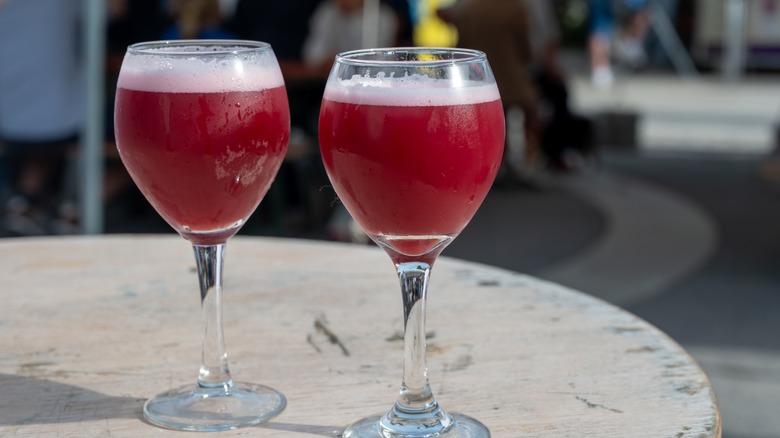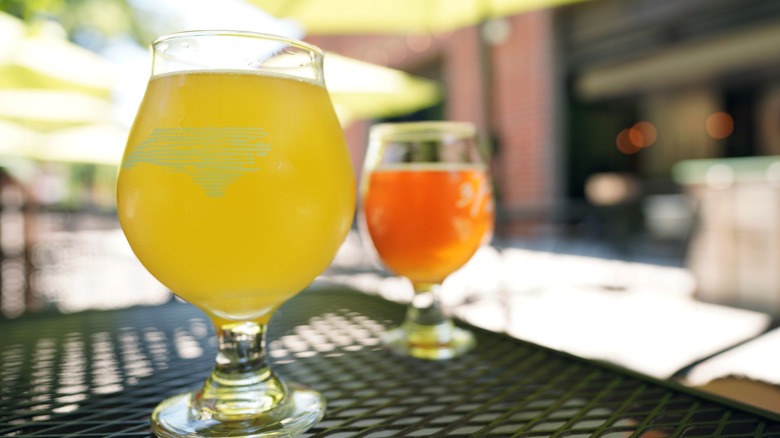Sour Vs Gose Beer: What's The Difference?
We get it — craft brewing terminology can be confusing. Maybe you know that there's a difference between ales and lagers, and words like "stout" and "pilsner" ring a bell, but anything more complicated than that makes your eyes glaze over. You may see sour beers and gose beers on the menu at many craft breweries, but if these terms might as well be Greek to you, allow us to explain. Sour beers are a broad category of brews characterized by tart or acidic flavors. Gose beers (pronounced like "goes-uh") are simply a type of sour with specific ingredients added to give them a distinct flavor profile that sets them apart from others in the same category.
Still confused? Think of it like the difference between bourbon and whiskey. All bourbon is whiskey, but not all whiskey is bourbon, just like all goses are sours, but not all sours are goses. While they fall into the same family, these two beers have different ingredients and brewing techniques to set them apart.
What is a sour beer?
A "sour" beer is an umbrella term that covers many different types of the drink. The science that goes into brewing one is what gives it that distinctive tart flavor. Live bacteria, namely Lactobacillus and Pediococcus, produce lactic acid, which our palates pick up as tangy or somewhat fruity. You know how yogurt has a particular tanginess to it? That is thanks to Lactobacillus and Pediococcus. Sour beer brewers will sometimes also use a strain of wild yeast often found on fruit skin called Brettanomyces (or simply Brett).
During the fermentation process, yeast produces esters, which are flavor compounds that give different kinds of beer their own unique tastes. Depending on the particular species of Brett yeast used, the resulting flavors can be fruity, citrusy, and maybe even a little funky (but in a good way). Some brewers will add fruit during fermentation to enhance these flavors, and some sours are brewed in an oak barrel to further encourage microbial activity.
Besides goses, other types of sour beers include Berliner Weisse, lambics, Flanders, Oud Bruin, gueuze, and American wild ales. While there is certainly variation amongst the different types, they are generally light, crisp, and refreshing. The tartness and subtle sweetness makes them easy to drink, even for folks who aren't huge beer fans.
What is a gose?
What sets a gose apart from other sour beers? They're brewed using Lactobacillus bacteria, so they still have a sweet tartness thanks to lactic acid production. However, the key difference is the addition of salt and coriander. Salt is known to help cut down on bitterness, and these ingredients give the beer hints of savory and floral notes to balance out the intense fruitiness that might make you pucker. Think of the lovely balance of salty and sweet flavors you get when you sip a margarita with a salted rim. Gose beers are pretty much that exact gustatory experience encapsulated in a brew. Additionally, goses are traditionally not made in oak barrels, while a variety of other sour beers are. Instead, goses are typically made via the kettle souring method, which uses a stainless-steel mash tun to quickly incorporate the sour flavors into unfermented beer (also known as wort).
A gose beer is a good introduction to the world of sours for someone who is hesitant to try a drink that proudly declares itself as "funky." The salt and coriander helps to tone down this flavor, and overall, it's an approachable, refreshing beer best enjoyed on a patio on a hot summer day. Whether you are a craft beer aficionado or a newcomer, the world of sour beers is just as vast and unique as the world of lagers or ales. While goses are a good place to start for folks new to the scene, sours have flavor profiles to suit a variety of preferences.


